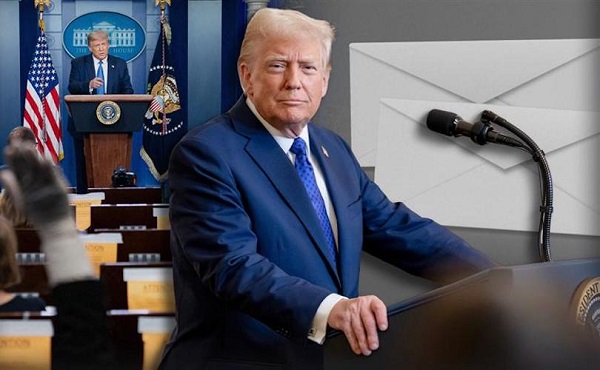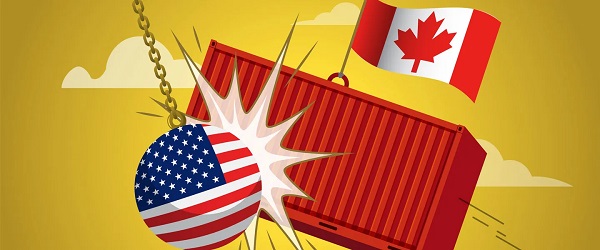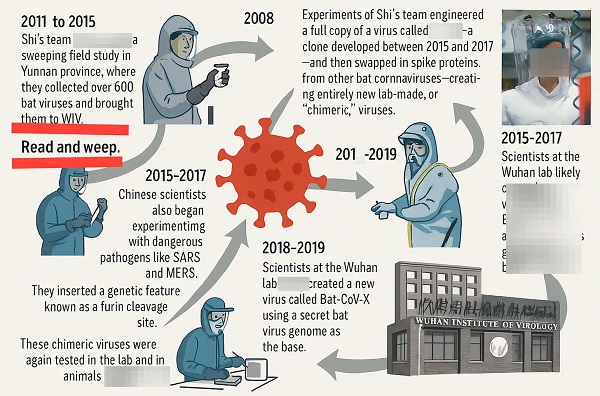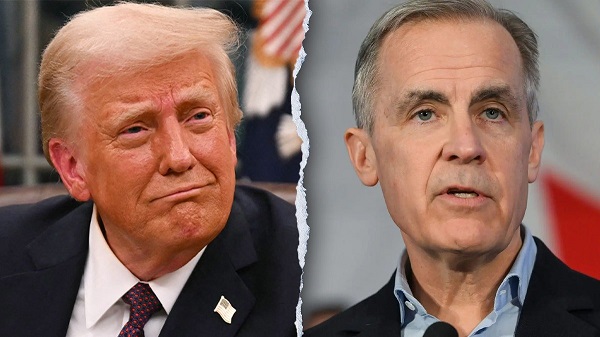International
Trump White House will ignore reporter emails that include ‘preferred pronouns’ in signature

From LifeSiteNews
“Any reporter who chooses to put their preferred pronouns in their bio clearly does not care about biological reality or truth and therefore cannot be trusted to write an honest story”
The White House will ignore all emails from reporters which include preferred gender pronouns in their email signatures according to Press Secretary Karoline Leavitt.
“Any reporter who chooses to put their preferred pronouns in their bio clearly does not care about biological reality or truth and therefore cannot be trusted to write an honest story,” Leavitt wrote in response to a request for comment from the New York Times.
The practice of citing one’s preferred gender pronouns, which is increasingly prevalent among leftists, stems from gender ideology, the idea that people have a “gender identity” that is distinct from their sex. Thus, for example, women who identify as males may include the gender pronouns “he/him” in their email signature or other identifiers.
Leavitt had previously stated to a NYT reporter who inquired about the potential closure of a climate research observatory, “As a matter of policy, we do not respond to reporters with pronouns in their bios.”
The New York Times reported that Katie Miller, senior advisor for the Department Of Government Efficiency (DOGE), had weeks prior declined another question from a Times reporter, for the same reason.
“As a matter of policy, I don’t respond to people who use pronouns in their signatures as it shows they ignore scientific realities and therefore ignore facts,” Miller said in an email. In a separate message, she noted, “This applies to all reporters who have pronouns in their signature.”
Business
Trumpian chaos—where we are now and what’s coming for Canada

From the Fraser Institute
As we pause to catch our breath amid the ongoing drama of President Donald Trump’s whack-a-mole tariff war, there’s both good and bad news from a Canadian perspective.
On the positive side, Canada (together with Mexico) was not specifically targeted when the president outlined the details of his so-called “reciprocal” tariffs on April 2. These new levies—ranging from 10 per cent to more than 40 per cent, depending on the country—will affect most categories of exports from virtually every U.S. trading partner, but fortunately not America’s two co-signatories to the Canada-U.S.-Mexico Agreement (CUSMA). Instead, apart from a handful of significant economic sectors (discussed below), Canadian exporters, for the moment, will be able to sell tariff-free into the U.S. market, provided they are compliant with the rules and paperwork requirements stipulated in CUSMA. That’s a ray of sunshine in an otherwise dark sky.
On April 9, the president agreed to a 90-day pause on his sweeping reciprocal tariffs, perhaps because of plunging U.S. and global stock markets and mounting fears of economic calamity. At the same time, he announced a jaw-dropping 125 per cent tariff on imports from China, which then immediately retaliated with steep duties of its own on all U.S. goods entering the country.
The risk remains that when the dust settles, the U.S will end up applying much higher tariffs on imports from most of the world. Should President Trump adopt the reciprocal levies announced on April 2 and stick with the 125 per cent tariff on imports from China, Yale University researchers estimate that the average effective U.S. tariff rate will soar to 25.3 per cent—more than 10 times higher than the average over the preceding 25 years. That’s one measure of the disruption that Trump has visited upon the international trading system.
For Canada, the average U.S. tariff would be lower, between 4 and 5 per cent, reflecting the benefits of CUSMA, albeit somewhat offset by the negative impact of the 25 per cent levies the U.S. is imposing on all imports of steel, aluminum, and motor vehicles and parts, along with separate punitive duties on softwood lumber imported from Canada. American tariffs on these Canadian export sectors will undoubtedly exact a toll on our economy. But the damage would be considerably greater if Canada was subject to across-the-board U.S. reciprocal tariffs.
Where does all of this leave Canada’s $3.3 trillion economy as of the second quarter of 2025?
Late last year, most forecasters were expecting a modest pick-up in growth after a notably lacklustre 2024, mainly thanks to lower interest rates and reduced borrowing costs for households and businesses. However, that widely-shared view didn’t account for President Trump’s wholesale assault on the global economic system—“a new economic crisis,” as Bank of Canada Governor Tiff Macklem described the situation in late March.
Back in February, the central bank took a stab at modelling the effects of matching U.S. and Canadian tariffs of 25 per cent, levied on all bilateral goods trade (apart from energy where a lower tariff rate was assumed). Its projections pointed to a permanent loss of Canadian economic output (real GDP) on the order of 2-3 per cent, a double-digit percentage decline in business investment, weaker consumption and a substantial fall in the value of Canadian exports over 2025/26. The Bank’s modelling also foresaw a lower Canadian dollar and a temporary jump in inflation, with the latter due primarily to Canada’s assumed retaliatory tariffs.
The macroeconomic scenario outlined in the Bank of Canada’s January study was dire enough, signalling a Canadian recession stretching over most of 2025 and well into 2026. But seen through today’s lens, the Bank’s earlier analysis looks too optimistic, as it failed to incorporate the worldwide dimensions of President Trump’s tariff barrage, including the scale of the retaliation planned by America’s aggrieved trading partners.
Even if it escapes the worst of Trump’s tariffs, Canada stands to suffer from a gruesome mix of slower global growth, a probable U.S. recession, and falling prices for oil, minerals and other natural resource products, which collectively comprise around half of the country’s international exports. Already there has been a marked erosion of Canadian business confidence, as reported in the Bank of Canada’s spring Business Outlook Survey, with one-third of firms now expecting a recession and hiring intentions sinking to the lowest level in a decade. Most respondents to the Bank’s survey also anticipate rising business input costs and higher Canadian inflation in 2025.
Worryingly, the latest Bank of Canada survey was completed in February; since then, the intensity of the Trumpian chaos has continued to increase. Among other things, the uncertainty that is an inevitable by-product of the president’s shambolic policymaking is having a decisively negative impact on business investment in many industries—in Canada, to be sure, but also in the United States. As two American business analysts recently observed: “With tariff policy shifting not day by day, but hour by hour… business investment is entirely paralyzed—and will continue to be frozen for the foreseeable future. That is exactly the opposite of what Trump intended.”
It doesn’t help that Canada is in the midst of a federal election, and that the government is therefore “otherwise occupied.” Once Canadian voters have spoken, the government elected on April 28 must deal with a deteriorating economy, navigate through the tariff fog and determine how to reset economic and security relations with our principal ally and commercial partner in the turbulent era of Trump 2.0.
2025 Federal Election
BLOCKBUSTER REPORT: Canada’s ties to Wuhan Institute of Virology and creation of COVID uncovered by Sam Cooper of The Bureau

Exclusive: CSIS Told Us We Were Infected at Wuhan Games, Soldier Says—But Ottawa Kept It Quiet
 Sam Cooper
Sam Cooper
CAF member has come forward with explosive testimony that Canadian intelligence agents assessed soldiers were infected with COVID-19 at the 2019 Wuhan Games—but the findings were buried in Ottawa.
“I was in Wuhan in the fall of 2019 at the World Military Games. A significant number of the team, and I myself, contracted COVID and became very, very ill.”
With that statement, delivered in confidential testimony to The Bureau, a Canadian Armed Forces member added his voice to one of the most powerful emerging revelations in the global search for the origins of COVID-19. His account closely matches the U.S. Department of Defense’s newly declassified conclusion that seven American soldiers fell ill with COVID-like symptoms during the same October 2019 military competition in Wuhan, China.
The American military investigation was ordered by Congress in 2021 but kept from the public until a Freedom of Information Act lawsuit forced its release. Critics now say the Biden administration suppressed the findings, which suggest U.S. intelligence agencies had early evidence of a viral outbreak tied to the Games.
The Canadian soldier believes voters deserve to know that CSIS—Ottawa’s civilian intelligence agency—also assessed that Canadian military athletes were infected in Wuhan, and that the Trudeau government chose not to inform the public. “Yes, CSIS and a number of other such organizations did interview members of the contingent,” he said of his experience upon returning to Canada. “They were professional and concerned only with facts. But when completing their interviews, they let it be known that their work and report would be suppressed.”
The Bureau has independently confirmed, through multiple confidential interviews, that Canadian intelligence did in fact interview military athletes and concluded they had experienced COVID-like symptoms while in Wuhan.
“The story of U.S. athletes becoming very sick while in Wuhan, or shortly after returning, and the institutional cover-up since—it mirrors exactly what Canadian Forces athletes experienced,” the CAF member explained.
“I say cover-up because, while it would have been difficult to know at the time that we had COVID, the timeline and intelligence were well known by May [2020.] Still, neither operational commanders or CAF health officials were willing or interested to conduct a fulsome assessment of the contingent.”
His testimony now stands alongside a torrent of new disclosures—including a bombshell release from the U.S. Defense Intelligence Agency—that together appear to draw a new, starker picture of what happened in Wuhan and how it may be linked to dangerous Canadian research.
The DIA documents, made public only after a Freedom of Information Act lawsuit by US Right to Know, include a 46-slide classified briefing dated June 25, 2020. It concludes that COVID-19 is most consistent with a lab-engineered virus created at the Wuhan Institute of Virology (WIV), likely under the direction of Dr. Shi Zhengli.
“Hypothesis: In mid-2019, one of the not fully characterized Bat-CoV-X chimeric viruses escaped from the WIV facilities and began infecting civilians in the city of Wuhan,” the document says.
In chronology, the DIA report focuses on a 2008 study co-authored by Dr. Shi, which showed that bat coronaviruses could be altered to infect human cells. The study described how swapping small genetic pieces in the virus allowed it to attach to human receptors. This work laid the foundation for later experiments in Wuhan that involved creating new hybrid viruses.
From 2011 to 2015, Dr. Shi’s team conducted a sweeping field study in Yunnan province, where they collected over 600 samples from multiple bat species living in caves and forested regions. The viruses were brought back to Wuhan and stored at the Institute—forming the core of a growing coronavirus research bank.
Shi’s team engineered a full copy of a virus called WIV1—a clone developed between 2015 and 2017—and then swapped in spike proteins from other bat coronaviruses—creating entirely new lab-made, or “chimeric,” viruses. According to U.S. intelligence analysts, this was one of the key human-made modifications that allowed the virus to more effectively bind to human cells—marking a potential step toward weaponizing the bat virus.
During this same 2015–2017 window, Chinese scientists also began experimenting with dangerous pathogens like SARS and MERS. They inserted a genetic feature known as a furin cleavage site—another significant modification known to increase a virus’s ability to infect human cells. These modified viruses were tested both in lab dishes and in live animals. The experiments were conducted under BSL-2 safety conditions, which in China are less strict than in the United States. According to U.S. military intelligence, Chinese BSL-2 labs have a documented history of leaks.
In this process, between 2017 and 2019, scientists at the Wuhan lab likely created a new virus called Bat-CoV-X using a secret bat virus genome as the base, the intelligence slide says. They continued building more versions by swapping in different genetic parts—especially the pieces that help the virus bind to human cells—and adding the furin cleavage site. These chimeric viruses were again tested in the lab and in animals throughout 2018 and into 2019, just before the outbreak began.
The final readable slide in the redacted DIA document concluded: “The molecular biology capabilities of WIV and the genome assessment are consistent with the hypothesis that SARS-CoV-2 was a lab-engineered virus that was part of a bank of chimeric viruses in Zhen-Li Shi’s laboratory at WIV that escaped from containment.”
By early 2020—when athletes around the world, including Canadian and U.S. soldiers, had already returned to their home countries with COVID-19-like infections—the Wuhan Institute of Virology and other Chinese government-controlled agencies began publishing studies promoting a natural zoonotic origin for SARS-CoV-2 and deflecting scrutiny from any laboratory origin theory.
The Canadian–Chinese Lab Connection
What makes the Defense Intelligence Agency’s timeline bombshell especially troubling for Canada is how closely it aligns with The Bureau’s earlier reporting on Dr. Xiangguo Qiu. Dr. Qiu was the now-expelled head of special pathogens at Canada’s National Microbiology Laboratory in Winnipeg. Canadian intelligence documents reviewed by The Bureau confirm that Qiu had an active working relationship with Dr. Shi Zhengli, the Wuhan lab, and the People’s Liberation Army, beginning in 2017. Together, they co-led research on Ebola and synthetic bat coronaviruses—projects funded by the Chinese Academy of Sciences and supported by CanSino Biologics, a state-owned company tied to China’s military.
In a previous interview with The Bureau, Dr. Asher said he could not reveal the classified intelligence his team reviewed. However, he made clear that his State Department investigators were deeply concerned that Beijing was using the Winnipeg lab for military intelligence gathering and bioweapons research.
“The Wuhan Institute of Virology wasn’t just a government lab creating novel pathogens—it was and is a civil-military fusion hub that had a biological intelligence operational collection mission ensconced in its web of nefarious activities,” Asher said, including “illicitly acquiring Ebola and doing research on bio-synthesis of this massively deadly pathogen, to make it super contagious.”
On April 10, Asher posted the newly released DIA report to social media, writing simply: “Read and weep.”
“I told people in the media and wrote repeatedly four years ago that, from the early days, U.S. Department of Defense and national lab analysts had highlighted the probability that COVID was created with synthetic biology,” Asher wrote. “Well now, thanks to US Right to Know, you can see one of several presentations on this likelihood from DIA.”
Although there is no evidence that Dr. Qiu transferred any bat coronavirus samples or physical materials related to the WIV bat project, the newly released U.S. intelligence raises the possibility that her intellectual contributions from Canada may have been more central than previously realized. At minimum, the documents confirm that Qiu was operating inside one of the world’s most advanced virology labs in Canada while simultaneously collaborating with the same Wuhan scientists now identified in the U.S. report as architects of a chimeric virus bank.
The documents also confirm that Wuhan scientists aggressively pressured Canadian researchers to share samples with the Wuhan Institute of Virology, and that Chinese military agents repeatedly breached security protocols at the Winnipeg lab—roaming unchecked through restricted areas—and clandestinely transported biological materials in and out while working with Dr. Qiu and her husband.
In detail, what the CSIS intelligence records show is that Dr. Qiu—a senior scientist at Canada’s National Microbiology Laboratory—began building formal ties with the Wuhan Institute and the Chinese Academy of Sciences in the years leading up to the pandemic. She applied to join the Thousand Talents Plan in 2017, a covert Chinese government program designed to recruit foreign experts. CSIS determined that the Wuhan Institute co-sponsored her application and that Qiu began receiving undisclosed funding through a secret Chinese bank account. She worked closely with Dr. Shi Zhengli, China’s top bat virus expert.
In June 2018, Dr. Qiu applied for a “high-end” research project through the Chinese Academy of Sciences, an institution CSIS describes as working closely with the People’s Liberation Army on dual-use biotechnology. This suggests a turning point: Dr. Qiu moved from academic collaboration to direct involvement in China’s military-linked pathogen research programs, effectively bridging Canada’s Winnipeg Lab with the Wuhan Institute of Virology on synthetic bat virus research.
Between 2018 and 2019, Dr. Qiu co-led two classified research streams with Dr. Shi at the Wuhan lab: one focused on gain-of-function experiments with Ebola, aimed at studying how the virus could be made more contagious; the second on synthetic bat coronavirus construction, building lab-made viruses.
In October 2018, a Wuhan lab technician referred to as “Individual 2” in CSIS reports was caught attempting to remove 10 unlabelled test tubes from the Winnipeg lab. While the contents have never been disclosed, the incident triggered internal alarms over unauthorized transfers. Then, in March 2019, Dr. Qiu and another Winnipeg scientist shipped live samples of Ebola, Nipah, and specially adapted virus strains to the Wuhan Institute of Virology. These transfers occurred just months before the U.S. intelligence timeline suggests a lab-engineered virus escaped containment in Wuhan.
While the Ebola and Nipah viruses she is known to have transferred are not coronaviruses, her scientific standing, access to biocontainment environments, and coordination with Dr. Shi suggest her work likely supported, directly or indirectly, the scientific environment that produced the agent of the COVID-19 pandemic. If the escape occurred in mid-2019, it would place Qiu and her prior visits to WIV in the direct window of critical research activities.
For Canadian readers and voters—as new revelations emerge about Chinese interference and apparent favouritism toward the Liberal government under Mark Carney—the Trudeau government’s failure to act on early intelligence warnings demands renewed scrutiny.
Canada’s intelligence agency raised red flags about Dr. Xiangguo Qiu’s activities as early as 2018. Yet collaboration with Chinese military-linked laboratories continued right up to the brink of the COVID-19 outbreak. Samples were transferred. Funding continued to flow. Warnings were dismissed. No one was held accountable.
For the Canadian soldier who came forward, at a minimum, Canadians should know more about China’s suspected role in the creation of the bat coronavirus and cover-up, and whether Canadian scientific capacity played a direct or indirect role.
“I have no special insights as to links with the Winnipeg lab, CCP/MSS infiltration there, or how this tied to COVID-19,” the Canadian soldier said. “That said, considering the vast, deep, and broad collusion between Canadian officials and organs of the PRC, nothing should be dismissed.”
The Bureau is a reader-supported publication.
To receive new posts and support my work, consider becoming a free or paid subscriber.
Invite your friends and earn rewards
-

 2025 Federal Election8 hours ago
2025 Federal Election8 hours agoLiberals Replace Candidate Embroiled in Election Interference Scandal with Board Member of School Flagged in Canada’s Election Interference Inquiry
-

 Alberta7 hours ago
Alberta7 hours agoIs Canada’s Federation Fair?
-

 Alberta6 hours ago
Alberta6 hours agoProvince introducing “Patient-Focused Funding Model” to fund acute care in Alberta
-

 espionage9 hours ago
espionage9 hours agoU.S. Experts Warn Canada Is Losing the Fight Against PRC Criminal Networks—Washington Has Run Out of Patience
-

 Automotive10 hours ago
Automotive10 hours agoTesla Vandals Keep Running Into The Same Problem … Cameras
-

 COVID-192 days ago
COVID-192 days agoCDC Vaccine Safety Director May Have Destroyed Records, Says Sen. Ron Johnson
-

 2025 Federal Election1 day ago
2025 Federal Election1 day agoWhat Trump Says About Modern U.S. And What Carney Is Hiding About Canada
-

 2025 Federal Election1 day ago
2025 Federal Election1 day ago‘Sadistic’ Canadian murderer claiming to be woman denied transfer to female prison







